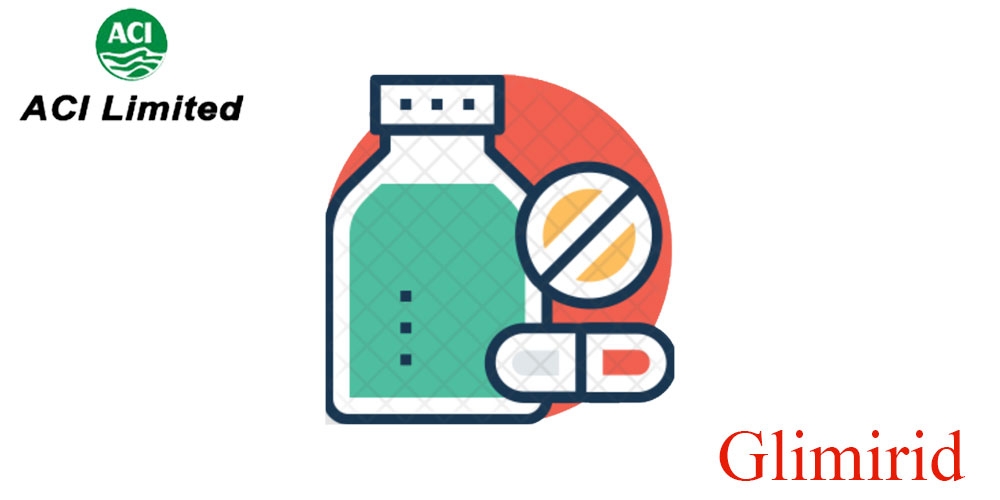ঔষধের বিস্তারিত বা বিকল্প ঔষধ জানতে ঔষধের নাম দিয়ে সার্চ দিন। যেমন- Napa বা Alatrol বা Amodis
Glimirid 3mg
TabletGlimepiride
ACI Pharmaceuticals
Other Strength:
- Glimirid 1mg
- Glimirid 2mg
- Glimirid 4mg
- Glimirid 5mg
Alternative:
- Diaryl 3mg
- Secrin 3mg
- Limaryl 3mg
- Dactus 3mg

Glimirid
Description
Glimirid® is the preparation of glimepiride. Glimepiride is an oral blood glucose lowering drug of the sulfonylurea class. The primary mechanism of action of glimepiride in lowering blood glucose appears to be dependent on stimulating the release of insulin from functioning pancreatic beta cells. In addition, extra pancreaticeffects may also play a role in the activity ofsulfonylureasuch as glimepiride.
Indications and uses
Glimirid®is indicated as an adjunct to diet and exercise to lower the blood glucose in patients with Non-Insulin-Dependent (type2) Diabetes Mellitus (NIDDM) whose hyperglycemia cannot be controlledby diet and exercise alone. Glimirid® may be used concomitantly with Metformin when diet, exercise and Glimirid® or Metformin alone do not result in adequate glycemic control.Glimirid® is also indicated for use in combination with insulin to lower blood glucose in patients whose hyperglycemiccannot be controlled by diet and exercise in conjunction with an oral hypoglycemic agent. Combined use of Glimirid® and Insulin may increase the potential for Hypoglycemia.
Dosage and administration
The usual starting dose of Glimirid®as initial therapy is 1-2 mg once daily, administered with breakfast or the first main meal.The maximum starting dose of Glimirid®should be no more than 2 mg. The usual maintenance dose is 1 mg to 4 mg once daily. The maximum recommended dose is 8 mg once daily. After reaching a dose of 2 mg, dosage increases should be made in increments of no more than 2 mg at 1-2 week intervals based upon the patient’s blood glucose response. Long-term efficacy should be monitored by measurement of HbA1clevels, for example, every 3 to 6 months.
Use in pregnancy and lactation
There are no adequate and well-controlled studies in pregnant women. On the basis of results from animal studies, Glimepirideshould not be used during pregnancy. Although it is not known whether Glimepirideis excreted in human milk, other sulfonylureas are excreted in human milk. Because of the potential for hypoglycemia in nursing infants may exist and because of the effects on nursing animals, Glimepirideshould be discontinued in nursing mothers.
Side effects
Hypoglycemia, dizziness, asthenia, headache, nausea,vomiting, gastrointestinal pain, diarrhea Leukopenia, agranulocytosis, thrombocytopenia, hemolytic anemia, aplastic anemia, and pancytopenia and allergic skin reactions, e.g., pruritus, erythema, urticaria, and morbilliform or maculopapular eruptions have been reported with sulfonylureas, including Glimepiride.
Contraindications
Glimepirideis contraindicated in patients withknown hypersensitivity to the drug, diabetic ketoacidosiswith
or without coma. This condition should be treated with insulin.
Precautions
Hypoglycemia:
All sulfonylurea drugs are capable of producing severe hypoglycemia. Proper patient selection, dosage and instruction are important to avoid hypoglycemic episodes. Patients with impaired renal function may be more sensitive to the glucose-lowering effect of Glimepiride.
Loss of control of blood glucose: When a patient stabilized on any diabetic regimen is exposed to stress such as fever,trauma, infection or surgery, a loss of control may occur. At
such times, it may be necessary to add insulin in combination with Glimepiride or even use insulin monotherapy.
Drug interaction
The hypoglycemic action of sulfonylureas may be potentiated bycertain drugs including non-steroidal anti inflammatory drugs and other drugs that are highly protein bound such as salicylates, sulfonamides, chloramphenicol, coumarins, probenacid, monoamine oxidase inhibitors, and beta-adrenergic blocking agents. When these drugs are administered to a patient receiving Glimepiride, the patient should be observed closely for hypoglycemia.
Overdose
Overdosage of sulfonylureas, including Glimepiride, can produce hypoglycemia. Mild hypoglycemic symptoms without loss of consciousness of neurologic findings should be treated aggressively with oral glucose and adjustments in drug dosage and/or meal patterns. Close monitoring should be continued until the physician is assured that the patient is out of danger. Serious hypoglycemic reactions with coma, seizure or other neurological impairment occur infrequently but constitute medical emergencies requiring immediate hospitalization. If hypoglycemia is diagnosed or suspected, the patient should be given a rapid intravenous injection of concentrated (50%) glucose solution. This should be followed by a continuous infusion of a more dilute (10%) glucose solution at a rate that will maintain the blood glucose at a level above 100mg/dl. Patient should be closely monitored for a minimum of 24-48 hours, because hypoglycemia may occur after apparent clinical recovery.
Pharmaceutical precaution
Store in a cool&dry place. Protect from light.
Presentation
Glimirid®1mg tablet: Each tablet contains Glimepiride INN 1mg.Glimirid®2mg tablet: Each tablet contains Glimepiride INN 2mg.Glimirid®3mg tablet: Each tablet contains Glimepiride INN 3mg.Glimirid®4mg tablet: Each
tablet contains Glimepiride INN 4mg.
Package quantities
Glimirid® 1mg Tablet: Each Carton contains30 tablets in Alu-PVCblister.Glimirid® 2mg Tablet: Each Carton contains 30 tablets in Alu-PVC blisterGlimirid® 3mg Tablet: Each Carton contains 30 tablets in Alu-PVC blister.Glimirid® 4mg Tablet: Each Carton contains 30 tablets in Alu-PVC blister.
এই পাতাটি ১৪২ বার দেখা হয়েছে
রাজডক কী?
ফ্রী সদস্য হোন Click Here
ডাক্তার হিসাবে যোগদান করতে Click Here
নার্স / টেকনোলজিস্ট হিসাবে যোগদান করতে Click Here
ফ্রী সদস্য হোন Click Here
ডাক্তার হিসাবে যোগদান করতে Click Here
নার্স / টেকনোলজিস্ট হিসাবে যোগদান করতে Click Here

